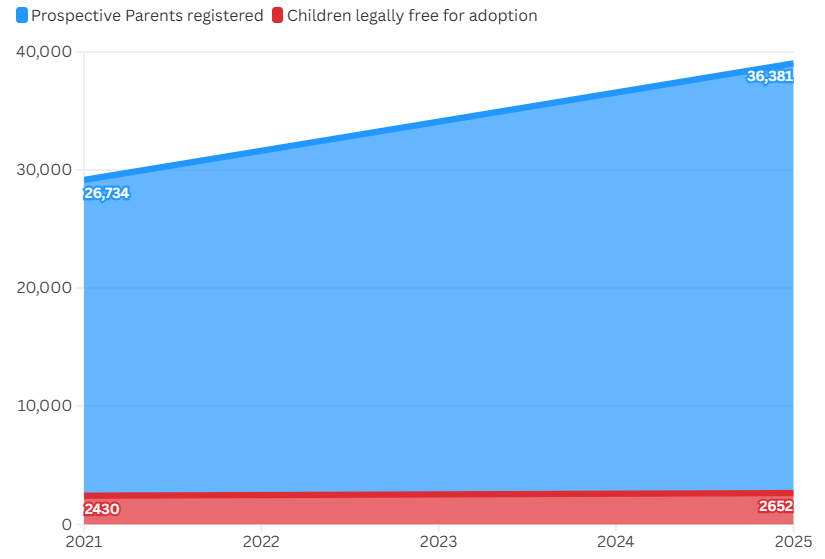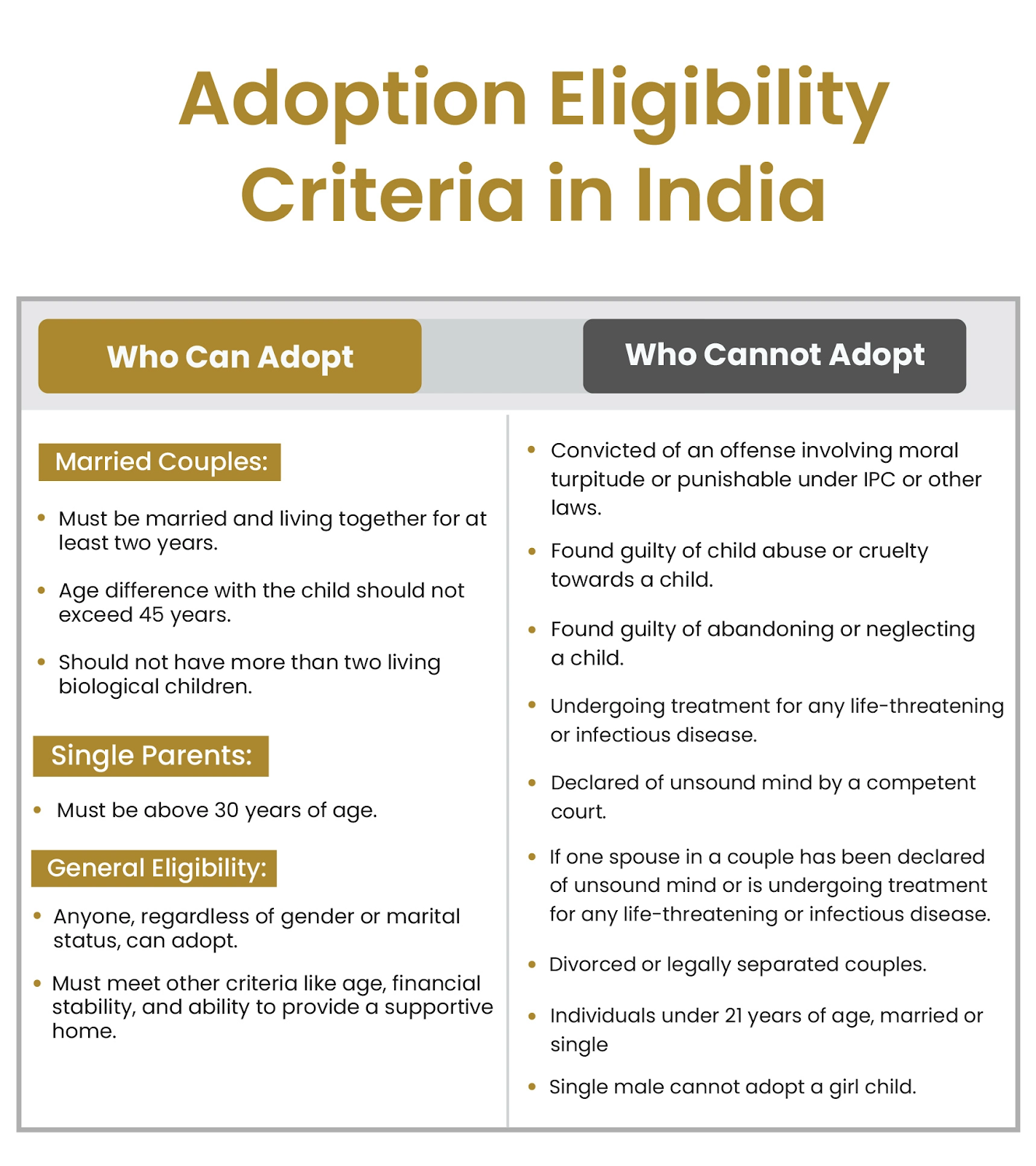Social Issues
Child Adoption in India
- 06 Aug 2025
- 8 min read
For Prelims: Adoption in India, Central Adoption Resource Authority, Hindu Adoption and Maintenance Act, 1956, Juvenile Justice (Care and Protection of Children) Amendment Act, 2021
For Mains: Laws Related to Adoption in India, Major Challenges Related to Adoption in India.
Why in News?
The Central Adoption Resource Authority (CARA) has been unable to bridge this gap between the number of children available for adoption and the number of prospective parents, resulting in prolonged delays in the adoption process.
- The waiting period for parents to receive an adoption referral has risen from 3 years in 2022 to approximately 3.5 years in 2025.
What is the Status of Child Adoption in India?
- State of Child Adoption in India: In 2024–25, 4,515 children were adopted, the highest since 2015.
- Of these, 4,155 were domestic adoptions, reflecting a growing acceptance of legal adoption in the country.
- Nodal Central Agency: The Central Adoption Resource Authority (CARA), established under the Juvenile Justice Act, 2015 is responsible for overseeing both domestic and international adoptions.
- State/UT Responsibility: The implementation of the Juvenile Justice Act, 2015 at the state and Union Territory level is carried out by various agencies, including:
- State Adoption Resource Agencies (SARA)
- Local Child Welfare Committees
- District Child Protection Units (DCPUs)
- Legal Framework:
- Hindu Adoption and Maintenance Act (HAMA), 1956: HAMA, 1956 permits legal adoption for individuals from the Hindu, Buddhist, Jain, and Sikh communities.
- Notably, adoptions under HAMA do not require registration with CARA.
- Juvenile Justice (Care and Protection of Children) Act, 2015: It governs adoptions for all citizens in India, regardless of religion.
- Under this Act, prospective adoptive parents are required to register on CARA’s portal, following which a Specialised Adoption Agency (SAA) conducts a Home Study Report (HSR).
- If found eligible, they are matched with a child who has been declared legally free for adoption.
- Hindu Adoption and Maintenance Act (HAMA), 1956: HAMA, 1956 permits legal adoption for individuals from the Hindu, Buddhist, Jain, and Sikh communities.
- International Framework: The Hague Convention on Protection of Children and Cooperation in Respect of Intercountry Adoption (1993) ensures that international adoptions are carried out in an ethical, legal, and transparent manner.
Central Adoption Resource Authority (CARA)
- About: CARA is a statutory & autonomous body under the Ministry of Women & Child Development.
- Objectives & Functions:
- It facilitates adoption of orphaned, abandoned, and surrendered children through its recognised adoption agencies.
- It monitors and regulates domestic adoptions under the Juvenile Justice (Care and Protection of Children) Act, 2015.
- It also serves as the Central Authority for inter-country adoptions under the Hague Convention on Intercountry Adoption, 1993, which India ratified in 2003.
What are the Key Challenges Hindering the Child Adoption Process in India?
- Widening Demand–Supply Gap: There is a significant gap between Prospective Adoptive Parents (PAPs) and adoptable children (13:1), with only a small fraction of children eligible for adoption due to issues like intact parental rights and lack of legal free status.
- Adoption delays have increased from 1 year in 2017 to 3.5 years in 2025, leading to concerns over illegal or informal adoptions, as highlighted by a Parliamentary Committee.
- Structural & Legal Hurdles: JJ Act, 2021 faces weak implementation, poor coordination among agencies, inadequate training, and legal hurdles like absentee guardians causing delays in adoption.
- The 2022 Standing Committee flagged inconsistencies between HAMA (simpler but lacks transparency) and the JJ Act (regulated but slower), raising concerns over trafficking and procedural delays.
- Mismatch in Age & Parental Preference: Around 34% of adoptable children are above 14 years, while most Indian parents prefer infants (0–2 years). This preference bias results in older and special needs children being overlooked.
- As per CARA data (2024), 60% of adopted children are female, and 80% belong to the 0–2 age group, reflecting a strong parental preference for younger children.
- High Rate of Child Returns: Between 2017–2019, there was a rise in adoptive parents returning children, 60% were girls, 24% had special needs, and many were over 6 years old.
- This reflects challenges in adjusting to adoptive homes due to inadequate counselling and preparation.
- LGBTQ+ Adoption & Legal Barriers: Due to traditional family norms and lack of legal recognition, LGBTQ+ individuals and couples face exclusion from formal adoption systems. This has led to a rise in informal or illegal adoptions within the queer community.
Eligibility Criteria for Prospective Adoptive Parents (Regulation 5 of Adoption Regulation, 2022)
Measures Taken to Improve Adoption and Foster Care in India
- Child Pool Expansion: CARA added children from Child Care Institutions (CCIs) to the legal adoption pool and classified them under 5 categories (Orphan, Abandoned, Surrendered, No Visitation, Unfit Guardianship) as per Supreme Court directions (SC, in 2023 while hearing a petition filed by a NGO)
- Digital Reforms: Upgraded CARINGS portal with Foster Care modules and new workflows for relative/step-parent adoptions, reducing processing time to 3–4 months.
- Mandatory Counselling (2025): CARA introduced structured counselling at pre-, during-, and post-adoption stages, with qualified counsellors to support adoptive families and children.
What Steps Can Be Taken to Strengthen and Streamline the Adoption System in India?
- Child-Centric Approach: Prioritize children’s right to family, care, and protection by shifting from parent-centric to child-centric adoption policies, aligned with the UNCRC.
- Simplify Adoption Procedures: Streamline JJ Act, 2021 and Adoption Regulations, 2022 with time-bound clearances, digital CCI–CARA integration, and dedicated adoption officers.
- Strengthen Psychosocial Support: Ensure proper implementation of CARA’s counselling mandate with trained professionals to minimise disruptions and support family bonding.
- Promote Awareness & Destigmatise Adoption: Launch IIEC (Information, Education, and Communication) campaigns to counter stigma around non-biological parenthood, and encourage adoption of older and special needs children.
|
Drishti Mains Question: Examine the social attitudes towards adoption in India. How can public awareness and institutional reforms together build a more adoption-friendly culture? |









